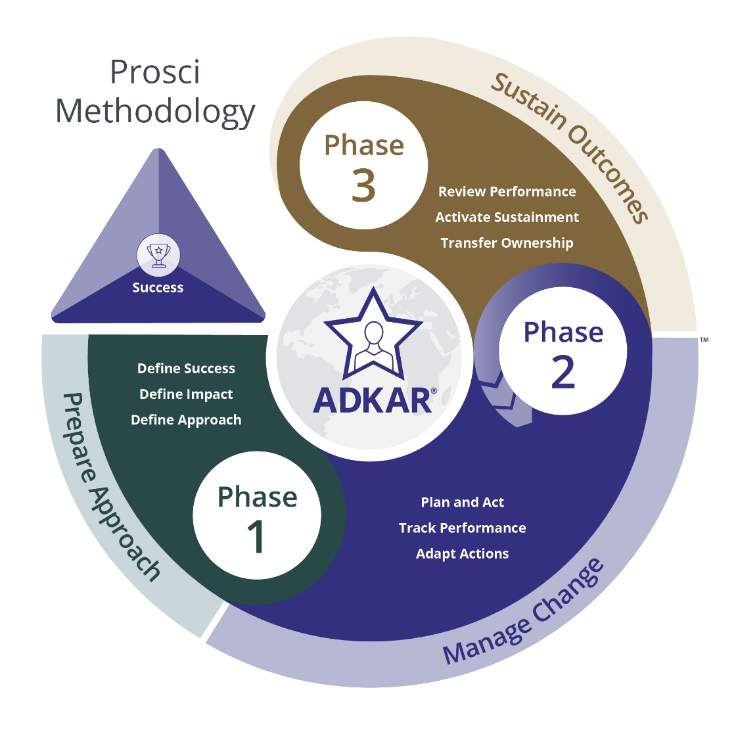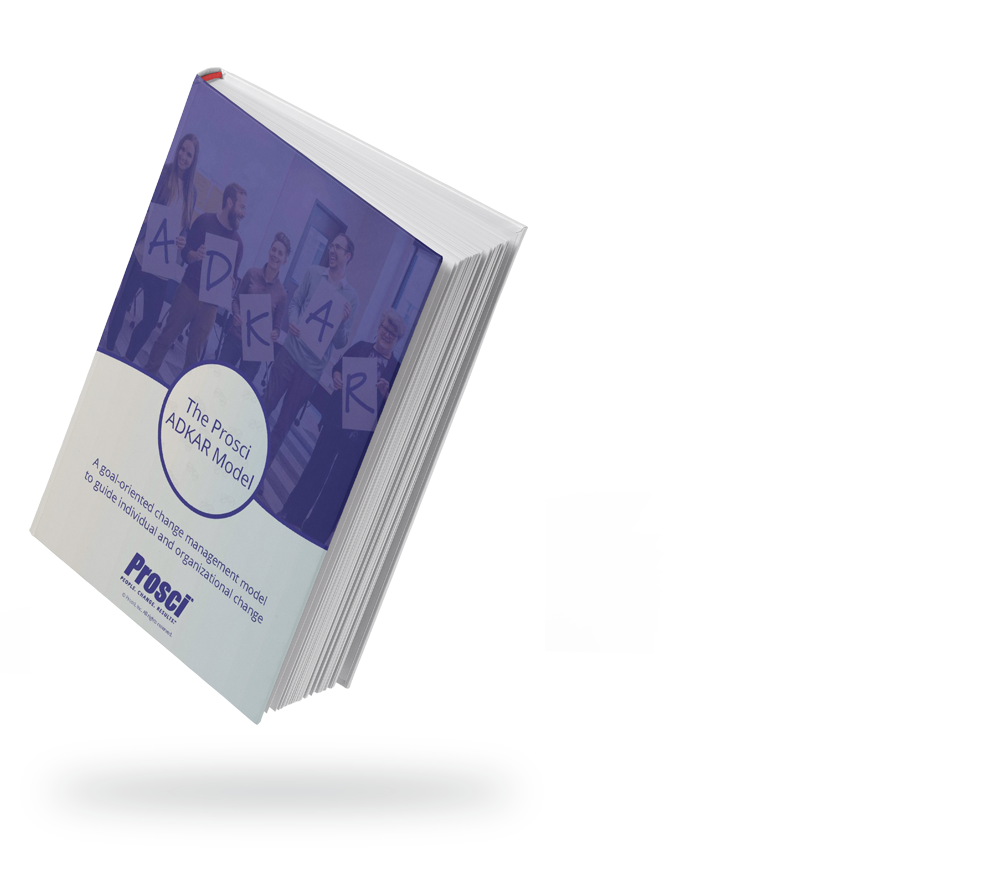The ADKAR Model, explained
A structured approach to make change happen, and make it stick.
A structured approach to make change happen, and make it stick.
…when we overlook the fundamental truth that organisational change happens one person at a time.
But how do you get everyone on board, aligned with the change and moving forward?
How can you help those who resist or “feel stuck” overcome obstacles?
And how do you keep people focused and committed?
Last but not least, how do you effectively measure change outcomes?
This is where ADKAR® comes into play. Evidence-based but intuitive to use, it streamlines the individual change process, empowering leaders, managers, and ultimately, the ones on the frontlines.
In short, the ADKAR Model takes the guesswork out of change efforts so that you can plan, implement and sustain the change easily and with confidence. With ADKAR, you multiply your chances of a successful outcome by 7.
Here is what you need to know to start with ADKAR and how you to get certified to make change happen on your team or organisation.
ADKAR was developed more than 20 years ago by Prosci after screening the change patterns of hundreds of organisations. Lessons learned and years of delivering consistent results have solidified the model, making it a cornerstone of the Prosci change management methodology.
A recurring mistake is the exclusive focus on the organisational top level. This perspective, akin to a “helicopter view”, disregards a critical aspect of reality: change comes to life on the frontlines, precisely where and when individuals adopt and use the solution.
A pivotal insight derived from Prosci research is that for the change to be successful, each and every member of the organisation has to through a sequence of 5 steps.
Enter ADKAR, a structured approach to make change happen, and make it stick.
ADKAR stands for Awareness, Desire, Knowledge, Ability and Reinforcement.
Think of each step as a building block of individual change.
Just as a whole building might crumble if you don’t lay the foundations properly, rushing through and missing steps is the fastest way to jeopardise the whole change initiative.
Too many organisations operate under the assumption that change can be declared and that things will fall into place on their own.
This approach leads them to hastily equip the people without ensuring genuine buy-in.
Change is not an email on Monday for training on Tuesday to go live on Wednesday!
Let’s do a quick recap with a real-life example. No matter your industry or location, you have likely come across the familiar “Save our Planet” sign displayed in hotel rooms.
It is a clear example of ADKAR communication in action. It derives its effectiveness from the simple but sequential structure of its message.
ADKAR is at the very heart of the Prosci Methodology.
It reflects the people-centric essence of the Prosci change management process and the fact that it is a foundational and versatile tool. It serves as a compass, a measuring stick, a common language, and more.
Because it outlines the goals and outcomes of the change in easy-to-understand terms and logically flowing steps, you will use ADKAR almost every step of the way:
The ADKAR model plays a significant role in phase 2 of the Prosci 3-phase process outlined in the graph below.
It facilitates effective planning and continues to be used throughout the management and sustainment phases for monitoring progress, identifying gaps, and implementing corrective actions.
ADKAR helps you understand where people stand at all times.
Empowering leaders and managers to help people navigate change confidently and break through barriers, ADKAR sets the stage for success for everyone involved.

Are you a change leader, project manager, IT specialist, HR partner, project team member or change practitioner?
Or maybe you are in a different role and eager to upskill?
If you are tasked with driving change within a team or across the organisation, the Prosci Change Management Certification Program will be a game-changer.
Immersive and interactive, it will help you move quickly from theory to practice.
Our extensive three-day training program is designed to help you master the ADKAR Model and the Prosci Methodology as a comprehensive approach to change management. You will gain a deep understanding of the fundamental aspects of the ADKAR Model and learn how it integrates with other models, tools, and processes.
Apply to an active project, get feedback from peers and instructors, and solve challenges right away.
Get more information on the Prosci Change Management Certification Program
Elevate your skills and become a change management expert in the most effective and holistic way possible. Walk out as a certified change manager and get the tools, material and support to successfully implement ongoing and future changes!
People frequently ask if change management is just communication.
Definitely not.
Communication is the third most important success factor for organisational change. Effective sponsorship and a structured approach to change are the top two contributors. That being said, communication presents a massive challenge, which ADKAR addresses as well.
Leaders and managers know the importance of clear communication.
But change can be messy and extremely demanding. That is even more the case in Agile environments, where sprints and releases introduce another layer of complexity.
The reality is that they often struggle with generating buy-in, maintaining engagement, and managing resistance.
ADKAR solves these problems in multiple ways:
No messy communication. ADKAR makes the change process easy to understand for everyone, keeping everyone aligned and moving in the right direction.
No steep learning curve, for faster results.
No rushing through projects. ADKAR emphasises the importance of investing in awareness and dialogue.
In essence, while managing change is not a simple act of communicating around the change, there is a lot of communication to organise and roles to activate. Consider leaders who stand as the face of the change or managers who play a vital role in facilitating adoption.
Here is a glimpse of what it means when we look at the change through the ADKAR lens:
In the Reinforcement phase, leaders and managers stretch their efforts to help solidify new behaviours, which also means celebrating successes.
Change is unquestionably a collaborative endeavour, which, despite its inherent complexity, can be structured and, most importantly, measured.
If you want to learn more, you can immediately access a curated selection of readings, rewatch our webinars or get more information about our next training session!
We cannot discuss CM and Agile integration, unless we explain how ADKAR gets reconfigured in Agile. If you are already familiar with PROSCI’s ADKAR model, you will find out how it supports individual transitions in an incremental environment. If you aren’t, we’ve got you covered. This post gives you everything you need to know, from a detailed breakdown of ADKAR’s change sequence to a comparative overview of how it operates when coupled with waterfall and Agile approaches. ADKAR at a glance. At the organisational level, change is nothing other than the sum of successful individual transitions, which can be achieved in five steps. Skip one or leave people behind, and the whole initiative will be ruined. Fail to put the right “building block” at the bottom, and the change will be, at best, short-lived. A powerful tool that has gradually become the change model standard, ADKAR can ...
Written by
Vincent PIEDBOEUF
Helping Senior Leaders spearhead the change with ADKAR
Change must be endorsed, sponsored and communicated properly. Failure to do so will only fuel resistance and lead to more organisational inertia. Conversely, genuine commitment from senior leaders usually produces a ripple effect which drives the adoption rate of change(s) among employees. We may behave as if these things were self-evident but the fact is that leaders have more often than not a poor understanding of their role. When the injunction to be active and visible throughout the project does not translate into actionable steps, it falls on deaf ears. That is when ADKAR® comes into play and why we dedicate a special post on the best and most effective ways to engage leaders. A quick read with practical insights backed by PROSCI’s research and participants’ hands-on experience[1]. Benefits of equipping senior leaders with ADKAR. Sponsorship is the prime source of success. But what it entails often remains ...
Written by
Vincent PIEDBOEUF
The 7 keys to making your change a success
Success is no accident. Even less so when it comes to dealing with change in uncertain times. With a healthy dose of Change Management, you can make the most of your transformational efforts and stay ahead of the game. And best of all, it can boost your chances of meeting your objectives on time and on budget by up to 6 times. No matter how big and daunting the task, we have your back covered. The 2018 benchmark report from our partner PROSCI incorporates the latest advances in CM research[1]. Here are, in a nutshell, the 7 keys – or top contributors - to making your change effective and long-lasting. Top contributor #1: active and visible sponsorship. Senior leaders must take the driver’s seat and lead by example. The biggest issue with this number one rule is that designated sponsors too often fail to understand what specific actions their role entails. The ABC ...
Written by
Vincent Piedboeuf
Do you want to know more about Prosci ADKAR Model?
Tell us briefly who you are and start your download
*This e-book is only available in English